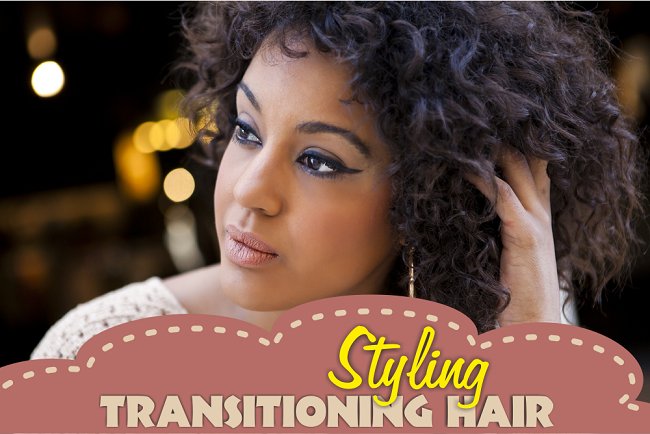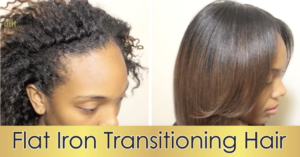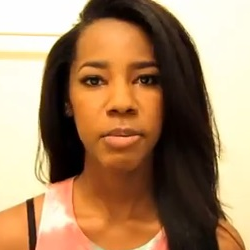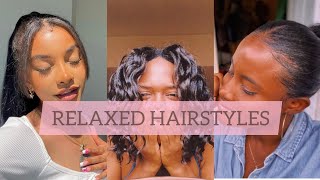Transitioning 101 - Styling Your Hair

Styling transitioning hair is very different from styling relaxed or natural hair. Going natural by long-term transitioning is the complete opposite of doing the Big Chop. Transitioning hair is temperamental and must be treated gently and patiently.
If you can’t muster up the strength to handle both textures then you may need to BC or take a break from your hair with a long term protective style. No sense is lying or glossing over what’s necessary to style or take care of transitioning hair. OK, maybe I’m being harsh.
I understand that some of our relaxer styling ways may still be with you but just be open to the idea that some may need to be dropped so that you can properly take care of your transitioning hair.
What to expect
Well, you have to expect different textures as your natural hair begins to grow in. First off, it’s may not your true natural texture that first grows in. That first hair is actually scab hair. Scab hair is not a scientific term but it’s a term used by those in the hair comunity to describe the initial hair that grows out as your transition to natural after you have been relaxing for a while.
Transitioning 101 – What Is Scab Hair And How Should You Deal With It?
Another thing to know about your hair is the line of demarcation. This is the weak area between the relaxed hair and the new growth of natural hair. It’s very fragile so be gentle and low manipulation is a must to keep breakage to a minimum.
Tips
Be gentle with your hair
I cannot stress this enough! Being rough will create breakage and all your hard work will be for nothing. Use wide tooth combs or a Denman brush* but don’t work with a rat tail comb* right now.
If you need it for parting then great but trying to rake that through three different textures with it will create a great deal of breakage. That comb used to glide through your relaxed tresses but now you are working with scab hair, natural hair and the line of demarcation, trust me, none of those respond well to that type of combing.
I wouldn’t advice a ton of brushing either while you are transitioning. Relaxed hair is stronger when dry but not transitioning hair. Brushing your hair when wet is better but don’t go crazy! Make sure you have conditioner, oil, cream or gel in your hair to help glide the brush and reduce the need for harsh brushing.
Wear curlier styles
Reason being it’s much easier to blend two (or 3) different textures in curlier styles than it will be in straighter styles. Styles like roller sets, flexi rods*, straw sets, and even Bantu knots work great with long term transitioners.
Wear extension hairstyles but in moderation and be smart about it!
Adding hair like weaves*, wigs* and braids should be done in moderation and smartly for two reasons.
► You need to learn how to care for your hair and the ONLY way to do that is to actually work with it. If you only wear wigs*, weaves and braids for two years of transitioning you may not know exactly how to work with your own hair once your transition is over.
Also your hair needs a break in between applications of added hair so give your hair a few days or weeks to rest before going to another extension hairstyle.
► Tight extension hairstyles will do more damage than good! Braids too tight or sewn in weaves* that are too tight may leave you with thinning edges, broken hairs or even bald spots.
I know that many of us feel that the tighter the braids it is the longer the style lasts but in your new regimen you won’t be wearing your extensions* for longer than 4-6 weeks anyway. Remember that your hair, particularly around the edges, is fragile so be cautious or you will be sorry in the end.
 Wear low manipulation styles
Wear low manipulation styles
The styles mentioned above like braid outs and curly rod sets are low manipulation. Wash and go’s and straighter styles are higher manipulation styles.
Low manipulation styles just mean you are not manipulating your hair daily and that cuts down on breakage drastically.
Beef up on your hair accessories
A lot of styles can be achieved with long term transitioning so here are some tools worth having:
► Bobby pins and/or hair pins
► Silk scarves*
► Headbands and flower clips
► Ouchless bands*
► Satin bonnets* and/or a satin pillowcase* for sleeping
Styles
The YouTuber Naturalista diimpulz has a GREAT video on 4 Easy, Stylish Ways to Bun Your Transitioning Hair. I would not have considered bunning a transitioning style but girlfriend shut me up with her technique, styles and ability to work a rat tail comb* without damaging her hair.
Her trick seems to be she really just uses it to part and to push her hair out of the way but never pulling it fully through the length of her hair. Diimpulz does everything right!
She doesn’t brush too hard nor does she run that rat tail comb* through her different textures of hair. You can clearly seen she is working with relaxed ends and natural hair at the same time but that doesn’t stop her from creating gorgeous bunning styles that many naturals sport on the regular.
She also combs and brushes while her hair is damp. This is a great video to show you how to work with your transitioning hair and how you are not limited by your choices of styles while you transition.
Kimberleyalecia never got bored while she transitioned as she tried EVERY style in the book! I had to share this video to show you how you can achieve any style you want while you transition.
I have the video starting at 1:12 when she discusses her long term transition and the many, many styles she rocked for about one year. She was amazing with her styles and yes she even has added hair extensions*.
What I love about this video is that her added hairstyles didn’t seem to damage her hair as every style looked great but it wasn’t too tight. This video is a great look book for styles to try while you long term transition.
The styles are there and you just need to know what your hair needs so you can have fun with the versatility of your hair without damaging it and regretting your decision to long term transition.




